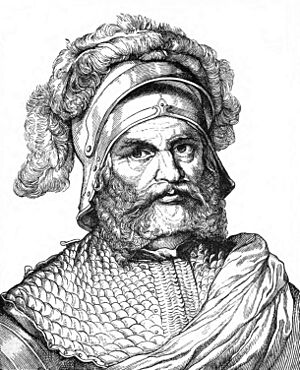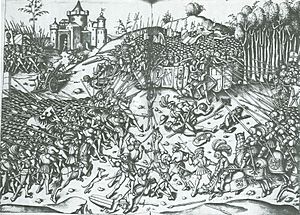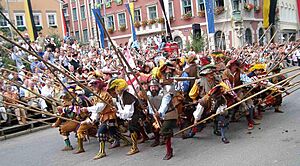Georg von Frundsberg facts for kids
Georg von Frundsberg (born September 24, 1473 – died August 20, 1528) was a famous German military leader. He served the Holy Roman Empire and the House of Habsburg. He was known for his new ideas about how infantry (foot soldiers) should fight.
Frundsberg became famous during the Italian Wars. He served under Emperor Maximilian I and later Emperor Charles V. People even called him "Vater der Landsknechte," which means "Father of the Landsknechte." This was because he was like a father figure to these special German soldiers. He gained great fame for helping the Habsburgs win the Battle of Pavia against France. He also played a big role in the War of the League of Cognac.
Contents
Early Life
Georg von Frundsberg was born in Mindelheim. His father, Ulrich von Frundsberg, was a captain in the Swabian League. His family was a very old line of knights from Tyrol. Georg was the youngest of nine sons. This meant he would not inherit his family's land. So, he was trained to be a warrior from a very young age. He grew up in the castle in Mindelheim. His father had bought this castle from Georg's uncle.
Military Career
In 1492, Georg joined his father in a military campaign. This campaign was against Duke Albert IV of Bavaria. But the duke gave in, so the fight was called off.
Learning New Tactics
Frundsberg fought for Emperor Maximilian I in the Swabian War of 1499. This war was against the Swiss Confederacy. During this time, he realized that the age of heavily armored knights was ending. He saw that foot soldiers were becoming more important.
In the same year, he helped the Imperial troops. They were sent to help Ludovico Sforza, who had lost his title as Duke of Milan. Maximilian then made Frundsberg a military captain in Tyrol. Frundsberg used what he learned from the Swiss. He created a strong army of infantry soldiers who fought in large square formations using long pikes.
Earning Knighthood
Frundsberg continued to serve Emperor Maximilian. In 1504, he fought in the War of the Succession of Landshut. He led a Landsknecht regiment in the important Battle of Wenzenbach. His soldiers used muskets and culverines (early firearms). They broke through the enemy's wagon defenses. After this victory, Emperor Maximilian I personally made him a knight.
Frundsberg believed that a strong army needed well-trained foot soldiers. So, he helped Maximilian organize the Landsknecht troops. A year later, he became the commander of the Landsknechts in the Habsburg Netherlands.
Campaigns Across Europe
From then on, Frundsberg spent his life fighting for the Empire and the Habsburgs. In 1509, he became the "Highest Field Captain" of the Landsknecht Regiment. He fought in the War of the League of Cambrai against the Republic of Venice. He became famous for defending Verona against many attacks. In 1512, he helped lead Imperial troops to retake Brescia.
After a short visit home, he returned to Italy. He won more fame fighting against the Venetians and the French. He led the Landsknechts alongside the Spanish commander Fernando d'Avalos in the 1513 Battle of La Motta. They defeated a much larger Venetian army. Frundsberg's motto was Viel Feind', viel Ehr' ("Many foes, much honor").
He then returned to Germany. In 1519, he led the infantry of the Swabian League. They helped remove Ulrich, Duke of Württemberg, from his duchy.
The Italian War of 1521–26
At the Diet of Worms in 1521, Frundsberg reportedly encouraged Martin Luther. During the Italian War of 1521–26, Frundsberg helped lead the Imperial Army into Picardy. King Francis I of France attacked with about 40,000 men. Emperor Charles V's army made a smart retreat. Frundsberg called this retreat "the greatest luck and most appropriate measure during war."
After the French campaign ended in 1522, Frundsberg briefly stepped down. But he soon returned to lead 6,000 men into northern Italy. They crossed the Alps through deep snow. In April, they fought the Battle of Bicocca near Milan. Swiss soldiers fought alongside Frundsberg, who led from the front. The emperor's victory at Bicocca brought most of Lombardy under Charles V's control.

In 1525, Frundsberg was made "Highest Field Captain" of the entire German Nation. He led 12,000 men to northern Italy. His goal was to help Pavia and save the Empire's Duchy of Milan. Frundsberg won his most famous victory at the Battle of Pavia. Even though the enemy was stronger, Frundsberg's forces captured the French king.
Final Campaign and Illness
Just one year later, in 1526, war in Italy started again. Frundsberg was called to help the Emperor's Army in Lombardy. He received some money, but it wasn't enough to raise a new army. So, Frundsberg borrowed money and even sold his family's silver and his wife's jewelry. He did this to get the funds needed to gather his soldiers.
In less than three weeks, Frundsberg organized over 12,000 men. They crossed the Alps in mid-November. He joined Constable de Bourbon near Piacenza and marched toward Rome. However, things went wrong near Modena on March 13, 1527. The soldiers hadn't been paid for months. Frundsberg could not control his Landsknechts anymore. This situation upset the old commander so much that he had a stroke.
Frundsberg never fully recovered his strength. He was moved back to Germany after a long time in Italian hospitals. He worried greatly about his soldiers, whom he called his "beloved sons." He also lost his personal wealth and one of his sons died. Georg von Frundsberg died in his castle in Mindelheim.
Legacy
Frundsberg was known as a skilled and honorable soldier. He was very loyal to the Habsburg rulers. One of his sons died in Italy in 1524. Another son, Caspar (1500–1536), and his grandson Georg (died 1586) were also notable soldiers. The family line ended with the death of his grandson.
His friends and fellow soldiers called him "Father of the Landsknechte." This name showed both his authority and how much he cared for his soldiers.
Cultural Depictions
Many stories and legends exist about Georg von Frundsberg's life. One of his first biographers, Adam Reißner, was his secretary. Reißner described many real events, even though he admired Frundsberg greatly. Another early source was the poet Oswald Fragenstainer, who was also a soldier under Frundsberg.
- The Frundsbergfest (Frundsberg Festival) in Mindelheim is one of Germany's largest historical festivals. It celebrates Georg von Frundsberg.
- Georg von Frundsberg is a character in the historical novel The Adventurer by Mika Waltari.
- In 1841, a statue of Frundsberg was added to the Walhalla memorial.
- Emperor Franz Joseph I of Austria had a statue of Frundsberg put in the Hall of Generals at the Vienna Museum of Military History in 1866.
- The Austro-Hungarian ship SMS Frundsberg, launched in 1873, was named after him.





